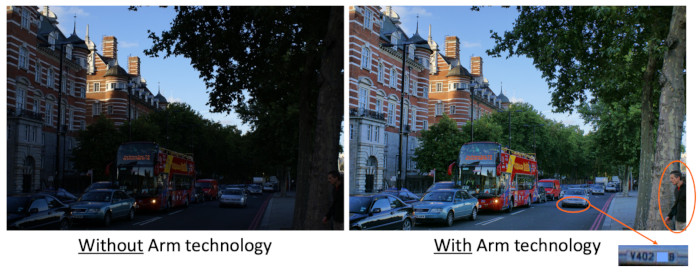
New Arm Mali-C52 and Mali-C32 Image Signal Processors Support HDR
Arm announced a new generation of image signal processors (ISPs), the Arm Mali-C52 and Mali-C32 ISPs.
A critical aspect of image technology used in devices is the ISP technology embedded within each of them. In these constrained devices, the key function of an ISP is to deliver the most accurate and highest image quality when pulling data from an image sensor and processing each pixel, particularly where machine learning is involved. The new Arm Mali-C52 and Mali-C32 apply over twenty-five processing steps to each pixel, of which three critical ones deliver differentiation in terms of image output quality. These include high-dynamic range (HDR), noise reduction and color management. By incorporating Arm’s Iridix technology and other algorithms for noise and color management, Mali-C52 and Mali-C32 ISPs efficiently deliver all three at high resolution and in real-time (e.g. 4k resolution at 60fps).
The best way to highlight the need for high-dynamic range (HDR) is to consider the image output from a connected outdoor security camera installed in a bright outdoor environment, which is usually a scene with very bright parts and deep shadows. While our eyes can naturally perceive contrast in these environments, digital sensors typically need multiple exposures to capture such a scene. To faithfully represent this HDR scene, image technology requires 20 or 24-bits of precision per pixel, but digital system displays are typically 8-bit or 10-bit, thus limiting the amount of data they can handle. This also means that any computer vision engine post the ISP is also bounded to 8 to 10-bit precision. In this scenario, the ISP needs to process HDR data (at higher bit depth), then compress it and utilize it further. Ultimately, if the dynamic range is not managed properly, then the details in the shadows are lost.
Arm says that the new Mali ISPs, with Arm’s dynamic range management and tone mapping technology, are designed to overcome these device limitations and enable viewers to see enhanced shadows, without touching or changing the highlights of the image.

The Mali-C52 can be configured for two different optimizations - image quality or area. The Mali-C32 is optimized specifically for area in lower-power, cost-sensitive embedded vision devices such as entry-level access control or hobby drones.
Both ISPs are a complete solution as Arm delivers the hardware IP along with ISP software drivers, including the 3A libraries (auto-exposure, auto-white balance, auto-focus) and the calibration and tuning tools. Features and benefits include:
- Higher ISP image quality: Iridix technology is designed to deliver a precise model of human retina contrast adaption, enabling cameras to see like the human eye.
- Higher performance as the ISP can process 600 megapixels/sec, which is essentially professional photography quality (e.g. DSLR) at premium smartphone-level frame rates.
- Complete software package for controlling the ISP, sensor, auto-white balance, auto-focus and auto-exposure. Both bare metal and Linux (Video4Linux framework - v4L2) software are provided.
- Flexible tuning: Tune it both objectively and subjectively with a full set of tuning and calibration tools. Specialized tuning training courses and support for tailored tuning for specific use cases and sensors are also available.





















